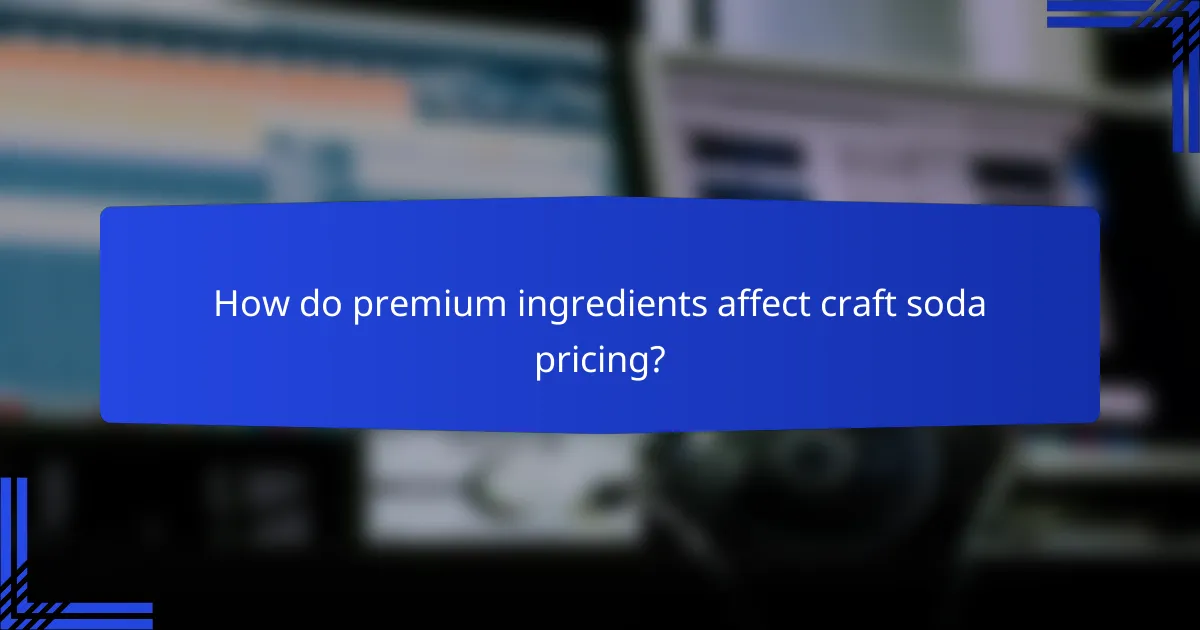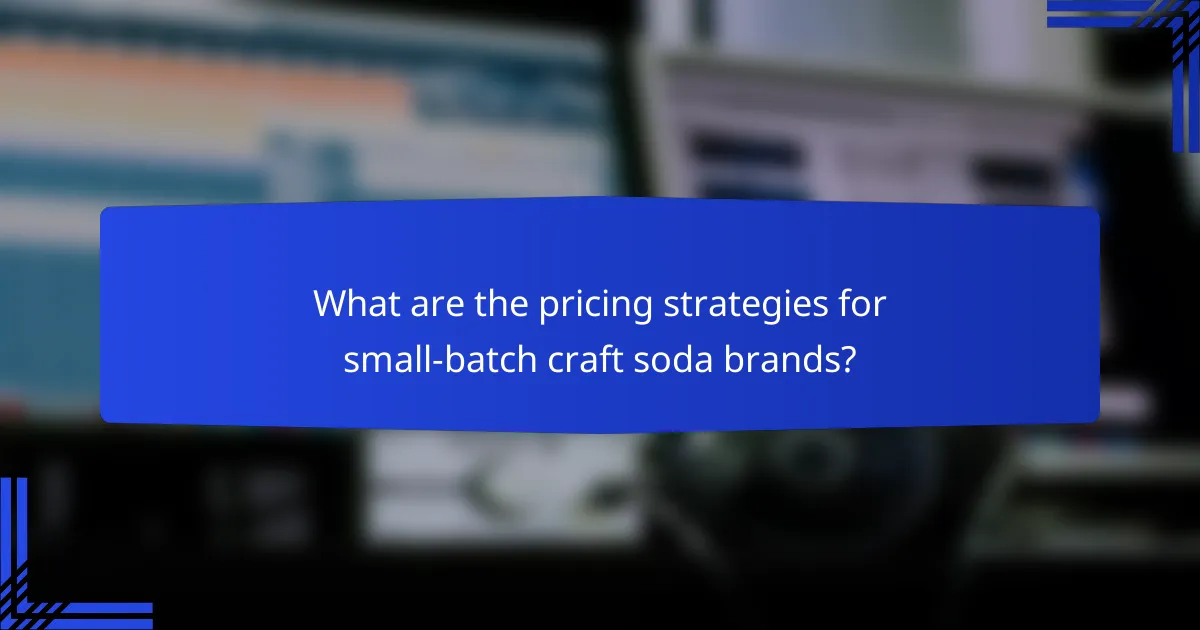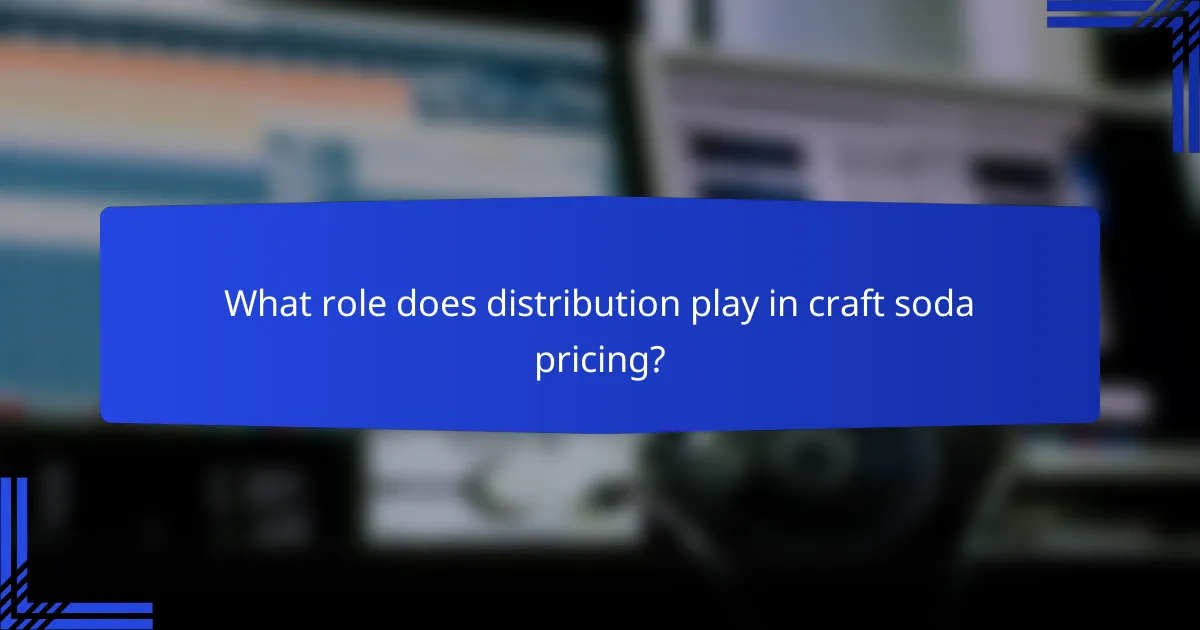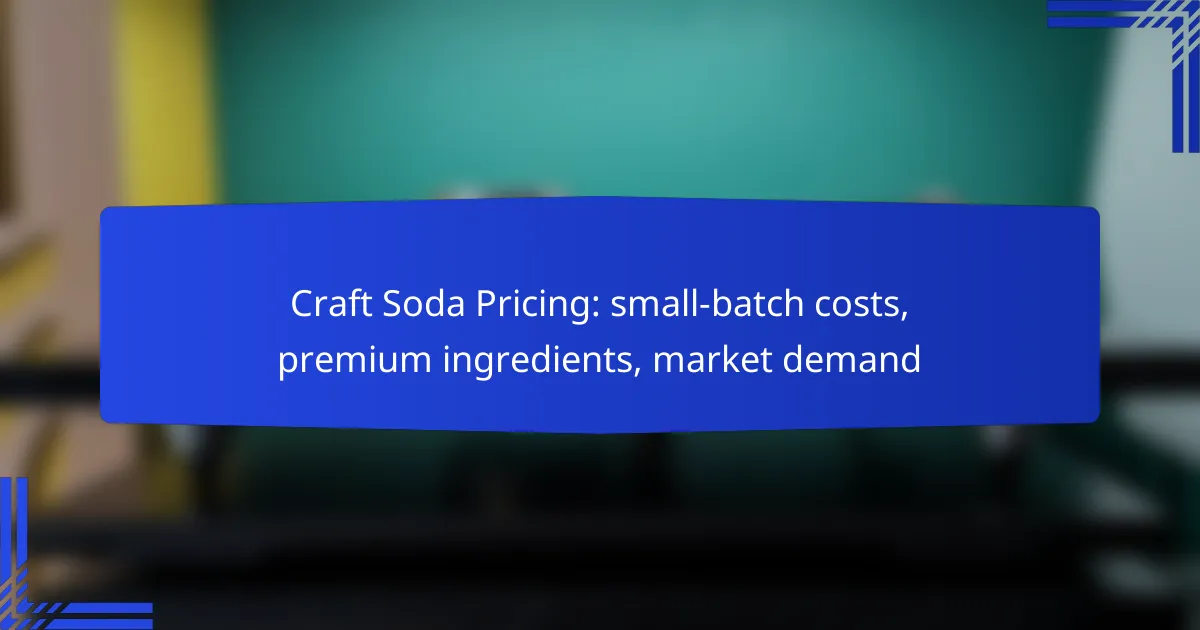Craft soda pricing typically ranges from AUD 3 to AUD 6 per bottle in Australia, influenced by factors such as ingredient quality and production methods. Small-batch sodas often carry a premium due to their use of unique flavors and artisanal techniques, which require higher production costs. Additionally, market demand is shaped by consumer preferences for health-conscious options and a growing interest in local brands, further driving the appeal of these distinctive beverages.

What is the average price of craft soda in Australia?
The average price of craft soda in Australia typically ranges from AUD 3 to AUD 6 per bottle, depending on factors like ingredients and production methods. Small-batch craft sodas often command higher prices due to their premium ingredients and unique flavors.
Price range for small-batch craft sodas
Small-batch craft sodas usually fall within the AUD 4 to AUD 8 range per bottle. The cost reflects the artisanal production process, which often involves sourcing high-quality, natural ingredients. Specialty flavors or limited editions may even exceed this range, appealing to niche markets.
When purchasing, consider the size of the bottle as well; many craft sodas are sold in smaller quantities, such as 330ml or 500ml, which can influence the price per liter. Always check for local brands, as they may offer competitive pricing and unique flavors.
Comparison with mass-produced sodas
Mass-produced sodas generally cost between AUD 1 and AUD 3 per bottle, making them significantly cheaper than craft options. The lower price point is largely due to economies of scale and the use of artificial ingredients and high-fructose corn syrup.
While mass-produced sodas dominate the market in terms of volume, craft sodas appeal to consumers seeking quality and unique taste experiences. This growing demand for artisanal beverages has led to an increase in craft soda offerings, further differentiating them from traditional soft drinks.

How do premium ingredients affect craft soda pricing?
Premium ingredients significantly increase craft soda pricing due to their higher production costs and sourcing challenges. These ingredients often include organic produce, unique flavorings, and artisanal methods, all of which contribute to a more expensive final product.
Cost implications of organic ingredients
Using organic ingredients in craft sodas can raise production costs by 20-50% compared to conventional options. This is primarily due to the more expensive farming practices and certification processes required for organic products. Additionally, the limited availability of organic ingredients can lead to higher prices in the market.
Craft soda producers should consider these costs when pricing their products. While organic ingredients appeal to health-conscious consumers, the price increase may limit the target market. Balancing quality with affordability is crucial for maintaining sales volume.
Impact of unique flavor profiles on pricing
Unique flavor profiles, such as exotic fruits or rare spices, can elevate craft soda prices significantly. These ingredients often come from niche suppliers or require specialized sourcing, which can add to the overall cost. Consumers are generally willing to pay a premium for distinctive flavors that enhance their drinking experience.
Producers should assess the market demand for specific flavors before investing heavily in them. Conducting taste tests or surveys can provide insight into consumer preferences and help determine if the higher pricing is justified. Additionally, limited-edition flavors can create a sense of exclusivity, allowing for higher price points while attracting adventurous consumers.

What factors influence market demand for craft soda?
Market demand for craft soda is influenced by consumer preferences, health trends, and the appeal of local brands. These factors shape purchasing decisions, driving interest in unique flavors and premium ingredients.
Consumer trends towards health-conscious beverages
As consumers become more health-conscious, they increasingly seek beverages that align with their dietary preferences. Craft sodas often use natural ingredients and avoid artificial additives, making them appealing to those looking for healthier options.
Many craft soda brands emphasize low sugar content or use alternative sweeteners, catering to the growing demand for functional drinks. This shift towards health-oriented choices can significantly impact sales and brand loyalty.
Popularity of local brands in Australia
In Australia, there is a strong preference for locally produced beverages, including craft sodas. Consumers often favor brands that source ingredients from nearby farms, enhancing the appeal of freshness and sustainability.
This trend is reflected in the success of various Australian craft soda makers who highlight their local roots and unique flavors. Supporting local businesses resonates with consumers, further driving demand for craft sodas in the market.

How does packaging affect craft soda costs?
Packaging significantly influences craft soda costs by determining material expenses, production processes, and consumer perceptions. The choice between glass and plastic, as well as the use of eco-friendly options, can lead to varying price points and market positioning.
Cost differences between glass and plastic bottles
Glass bottles typically incur higher costs than plastic due to their production, transportation, and recycling processes. While glass offers a premium feel and better preservation of flavor, it can increase retail prices by a notable margin, often by 20-50% compared to plastic alternatives.
Plastic bottles, on the other hand, are lighter and cheaper to produce, leading to lower shipping costs. However, they may not convey the same artisanal quality that consumers expect from craft sodas, potentially affecting sales in premium markets.
Influence of eco-friendly packaging on pricing
Eco-friendly packaging options, such as biodegradable materials or recycled content, often come with increased costs due to sourcing and production challenges. These sustainable choices can raise prices by 10-30%, depending on the materials used and the scale of production.
Despite the higher costs, many consumers are willing to pay a premium for environmentally friendly packaging, viewing it as a reflection of brand values. Craft soda producers should weigh the potential for higher sales against the increased production costs when considering eco-friendly options.

What are the pricing strategies for small-batch craft soda brands?
Small-batch craft soda brands typically employ various pricing strategies to reflect their unique offerings and market positioning. These strategies often consider production costs, ingredient quality, and consumer demand to determine optimal pricing.
Value-based pricing models
Value-based pricing focuses on setting prices based on the perceived value of the product to the customer rather than solely on production costs. For small-batch craft sodas, this means pricing can be higher if consumers believe the premium ingredients and unique flavors justify the cost.
Brands may conduct surveys or focus groups to gauge customer willingness to pay, which can help in establishing a price point that aligns with consumer expectations. For example, a craft soda made with organic ingredients might be priced significantly higher than mass-produced alternatives, reflecting its perceived quality.
Competitive pricing analysis
Competitive pricing analysis involves examining the prices of similar products in the market to determine a suitable price for small-batch craft sodas. This strategy helps brands position themselves effectively against competitors while ensuring they remain attractive to consumers.
Brands should analyze the pricing of both direct competitors and broader beverage categories. For instance, if similar craft sodas are priced between $3 and $5 per bottle, a new brand might choose to price its product within this range to remain competitive. However, they should also consider their unique selling points, such as flavor innovation or local sourcing, which may allow for a premium price.

How do seasonal flavors impact craft soda pricing?
Seasonal flavors significantly influence craft soda pricing due to their limited availability and the use of premium ingredients. These unique offerings often command higher prices, reflecting both the cost of production and consumer demand for exclusive tastes.
Price variations for limited edition releases
Limited edition craft sodas typically see price variations that can range from 10% to 50% higher than standard flavors. This increase is often attributed to the use of rare ingredients and the small-batch production process. For example, a seasonal gingerbread soda might retail for around $5 per bottle, compared to $3 for a regular flavor.
Retailers may also mark up prices during peak seasons, such as the holidays, where demand for unique flavors surges. This can lead to further price adjustments based on market trends and consumer interest.
Consumer willingness to pay for seasonal exclusivity
Consumers often exhibit a strong willingness to pay a premium for seasonal craft sodas, driven by the desire for unique experiences. Many are willing to spend more for flavors that evoke nostalgia or seasonal celebrations, such as pumpkin spice in the fall or cranberry in winter.
Surveys indicate that a significant portion of craft soda drinkers may pay up to 30% more for limited-time offerings. This trend highlights the importance of marketing seasonal flavors effectively to maximize consumer interest and sales potential.

What role does distribution play in craft soda pricing?
Distribution significantly impacts craft soda pricing by influencing costs associated with transportation, storage, and retail markup. The choice between direct-to-consumer sales and retail partnerships can affect the final price consumers pay for these beverages.
Direct-to-consumer vs retail pricing
Direct-to-consumer pricing often allows craft soda producers to offer lower prices since they eliminate middlemen and can pass savings directly to customers. This model typically involves online sales or local events, where producers can retain a larger share of the revenue.
In contrast, retail pricing includes additional costs such as shelf space fees and retailer markups, which can raise the final price for consumers. Craft sodas sold in stores may range from a few dollars to over ten dollars per bottle, depending on the brand and market positioning.
Impact of local distribution on costs
Local distribution can greatly affect the cost structure of craft sodas. Producers who distribute within a limited geographic area often benefit from lower transportation costs and fresher products, which can enhance their pricing strategy.
However, if a craft soda brand aims to expand its reach, it may incur higher logistics costs, impacting pricing. Understanding local market demand and competition is crucial for setting prices that remain attractive while covering distribution expenses.

What emerging trends are shaping craft soda pricing?
Craft soda pricing is increasingly influenced by the growth of the non-alcoholic beverage market and a shift towards sustainable production practices. These trends reflect changing consumer preferences and a heightened demand for quality ingredients and ethical production methods.
Growth of non-alcoholic beverage market
The non-alcoholic beverage market has seen significant expansion, driven by health-conscious consumers seeking alternatives to traditional sodas and alcoholic drinks. This growth has led to an increase in craft soda offerings, which often come with premium pricing due to their unique flavors and artisanal production methods.
As demand rises, craft soda brands are positioning themselves as premium products, often priced higher than mass-produced options. Consumers are willing to pay a premium for distinctive flavors and high-quality ingredients, which can range from organic cane sugar to exotic botanicals.
Shift towards sustainable production practices
Many craft soda producers are adopting sustainable practices, which can impact pricing. Sourcing organic or locally grown ingredients often results in higher costs, which are reflected in the final price of the product. Consumers increasingly value transparency and sustainability, making them more likely to support brands that prioritize these practices.
For example, brands that use eco-friendly packaging or support local farmers may charge more, but they attract a loyal customer base willing to pay for ethical consumption. This trend not only enhances brand reputation but also aligns with the growing consumer expectation for environmentally responsible products.
